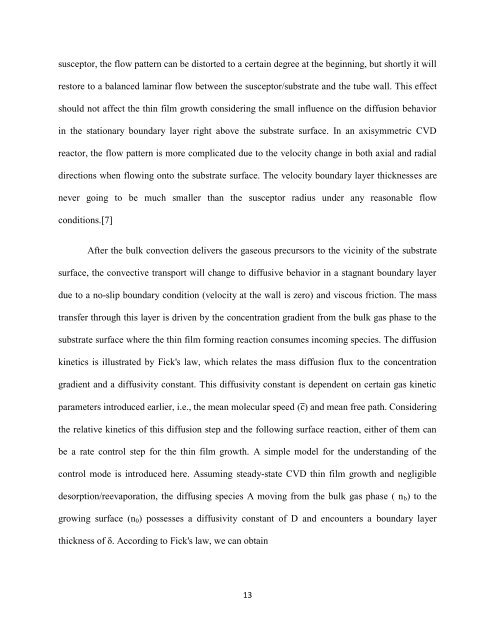CHEMICAL VAPOR DEPOSITION OF THIN FILM MATERIALS FOR ...
CHEMICAL VAPOR DEPOSITION OF THIN FILM MATERIALS FOR ...
CHEMICAL VAPOR DEPOSITION OF THIN FILM MATERIALS FOR ...
You also want an ePaper? Increase the reach of your titles
YUMPU automatically turns print PDFs into web optimized ePapers that Google loves.
susceptor, the flow pattern can be distorted to a certain degree at the beginning, but shortly it will<br />
restore to a balanced laminar flow between the susceptor/substrate and the tube wall. This effect<br />
should not affect the thin film growth considering the small influence on the diffusion behavior<br />
in the stationary boundary layer right above the substrate surface. In an axisymmetric CVD<br />
reactor, the flow pattern is more complicated due to the velocity change in both axial and radial<br />
directions when flowing onto the substrate surface. The velocity boundary layer thicknesses are<br />
never going to be much smaller than the susceptor radius under any reasonable flow<br />
conditions.[7]<br />
After the bulk convection delivers the gaseous precursors to the vicinity of the substrate<br />
surface, the convective transport will change to diffusive behavior in a stagnant boundary layer<br />
due to a no-slip boundary condition (velocity at the wall is zero) and viscous friction. The mass<br />
transfer through this layer is driven by the concentration gradient from the bulk gas phase to the<br />
substrate surface where the thin film forming reaction consumes incoming species. The diffusion<br />
kinetics is illustrated by Fick's law, which relates the mass diffusion flux to the concentration<br />
gradient and a diffusivity constant. This diffusivity constant is dependent on certain gas kinetic<br />
parameters introduced earlier, i.e., the mean molecular speed ( ) and mean free path. Considering<br />
the relative kinetics of this diffusion step and the following surface reaction, either of them can<br />
be a rate control step for the thin film growth. A simple model for the understanding of the<br />
control mode is introduced here. Assuming steady-state CVD thin film growth and negligible<br />
desorption/reevaporation, the diffusing species A moving from the bulk gas phase ( nb) to the<br />
growing surface (n0) possesses a diffusivity constant of D and encounters a boundary layer<br />
thickness of δ. According to Fick's law, we can obtain<br />
13

















